In Berkeley, California, 75% of Black Students Graduate One of Highest Graduation Rates in United States for Black Students | |
Berkeley has best success with black students in US By Camilo Smith 09/20/2011  Graduation Day, July 11, 2011 (Berkley Unified School District) One of the school districts with over 75 percent of its African-American student body graduating is located on the West Coast. Out of 271 African-American students who attended Berkeley High School, 205 graduated last year. That's one of the highest African-American graduation rates in the country. The Berkeley Unified School District made closing the education gap a top priority. Just three years ago the school district, led by a grassroots coalition of community, civic and religious organizations, including the group Parents of Children of African Descent initiated a program called the 2020 Vision program. The program's sole focus is to close the achievement gap in Berkeley public schools by the year 2020. In June 2008, the Berkeley City Council and Berkeley Unified School District School Board adopted resolutions that sought to improve education along racial lines to eliminate disparities between white and Asian students and black and Latino kids. "It's not just the district. It's the city of Berkeley, the university, the people and faith-based organizations," said Debbi D'Angelo District Director of Research and Berkeley Evaluation and Assessment. "It's just so powerful. Everybody is working together." The Berkeley school district has had the benefit of parcel taxes to apply towards meeting the equity goals for students of color. The funds are used to pay for data and teacher training, among other things. "I think that the things we have done is to make the education more personal," says Karen Hemphill, an African-American mother of a recent Berkeley High School graduate. Another son is in his junior year at the school. Hemphill, who is also a member of the school board, says that about five years ago the city began looking at ways to close the education gap. Officials took notice that a problem was brewing, Hemphill said, because a health department study in 2006 referenced Berkeley's racial education disparity as a growing problem for the community. According to Hemphill, the school system began to look at how it was teaching children before high school. "We stressed elementary school and middle school. We were really focusing on Algebra I, Geometry and Biology," she says about the core classes that most successful students take by the time they reach high school. One of the middle schools in the city, which is about 80 percent students of color, was cited by Education Secretary Arne Duncan for its scholastic achievement. Berkeley's latest schools data comes from the children who entered high school from 2006 to 2010. They were part of a more decentralized school, says Hemphill. The high school is broken up into smaller "mini-schools" that specialize in specific subject matter, such as a the Green Academy that focuses on ecology. There's also a school for biotechnology. But it's not just the academics that are the draw for students. The school has no shortage of extracurricular activities, which former students and schools officials alike say make it a positive environment for young people. "There's a lot to engage kids on campus, so that kind of keeps them there," Hemphill says | |
Wednesday, September 28, 2011
Berkeley has best success with black students in US
Sunday, September 25, 2011
Wednesday, September 21, 2011
The Ten Most Dangersous Cities in America
The Ten Most Dangersous Cities in America We must bring hope, education and economic revitalization to these cities to change their plight! | |
The Most Dangerous Cities in America by Douglas A. McIntyre, Michael B. Sauter and Charles B. Stockdale Wednesday, May 25, 2011 Earlier this week, the FBI trumpeted the news that violent crime dropped 5.5% in 2010 while reported property crimes fell 2.8% during the depths of the worst economic slowdown since the Great Depression. The news, though, is far from positive. Though most regions of the U.S. saw declines, the Northeast saw an increase in murders (8.3%), forcible rapes (1.4%) and aggravated assaults (0.7%). Why that region was affected by crime more than others isn't clear. Perhaps it was because of the grinding poverty found in some of the area's cities and their high cost of living. The Police Executive Research Forum polled 233 local law enforcement agencies in 2009, and found that the link between poverty and crime was inextricable. A prolonged recession would only make matters worse, the research showed. After reviewing the data, PERF Executive Director Chuck Wexler told Reuters, "We are not saying there is going to be a crime wave, but we are saying this is a wake-up call and we anticipate the situation will continue to deteriorate." A 24/7 Wall St. review of 2010 FBI crime data shows violent crime rose in several of the largest and poorest cities in the U.S., particularly those which have been in decline for some time. Even when crime rates dropped, older urban areas still had more violent crime than other cities. Philadelphia, Cleveland, Buffalo and Hartford finished high on the FBI's list but failed to make the final 24/7 Wall St. ranking. The crime problem is not completely explained by crimes committed. Police forces are supposed to keep crime rates down, but officers have begun to disappear from the streets of some large cities. Pontiac, Mich., part of the corridor of high crime cities that runs from Detroit to Flint, recently turned over its police operations to the sheriff's office of Oakland Country, where Pontiac is located. Old industrial towns need to cut costs as populations fall and tax receipts recede, but the money trouble almost makes it certain that criminal activity will grow because it is mostly unchecked. 24/7 Wall St. looked at the ten most crime-plagued cities in the U.S. with populations of more than 100,000. We used a measurement of crimes per thousand people which is part of the new FBI database to determine the order. We compared these figures to unemployment rates and median income. The recession may have ended, but crime has not eased in these troubled cities nor will it anytime soon. Our list is dominated by towns like Detroit, New Haven, and Baltimore. Parts of these cities are fortresses of crime. Much of the violent crime in Detroit is committed in the old Palmer Avenue section of the city, which is far from the shiny skyscrapers where GM has its headquarters. Baltimore's Front Street neighborhood is a world away from the new office towers of companies like financial giant T Rowe Price on Pratt Street. The crime-plagued Lamar Avenue section of Memphis is also far from the city's ritzy neighborhoods. Unemployment will inevitably improve in these cities. The most hard-hit sections, however, may never completely recover. They failed to do so after the last economic upswing -- and the one before that. Some part of all the cities on this list will be home to high levels of violent crime permanently. And, if the money used to keep police on the streets falls in most of these municipalities, containing the problem to a few neighborhoods will be hard. It would be nice to believe that criminals sit out a recovery, but they don't. These are America's 10 Most Dangerous Cities: 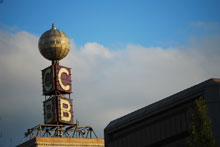 1. Flint, Michigan 1. Flint, MichiganPopulation: 109,245 Violent Crime Per 1,000: 22 2010 Murders: 53 Median Income: $27,049 (46.1% below national average) Unemployment Rate: 11.8% (2.8% above national average) The number of violent crimes committed in Flint increased for all categories considered for this list between 2009 and 2010. Perhaps most notably, the number of murders in the city increased from 36 to 53. This moves the city from having the seventh highest rate of homicide to the second highest. The number of aggravated assaults increased from 1,529 to 1,579, a rate of 14.6 assaults per 1,000 residents, placing the city in the No. 1 rank for rate of assaults. Flint police chief Alvern Lock stated late last year that he believed the city's violence stemmed from drugs and gangs. Flint has a relatively small median income of about $27,000 per household. The city also has a poverty rate of 36.2%.  2. Detroit, Michigan 2. Detroit, MichiganPopulation: 899,447 Violent Crime Per 1,000: 18.9 2010 Murders: 310 Median Income: $26,098 (48% below national average) Unemployment Rate: 12.7% (3.7% above national average) The city crippled the most in America's post-industrial era is almost certainly Detroit. The Motor City has suffered from high rates of unemployment, homelessness, and crime. The city has one of the ten highest rates for three of the four types of violent crime identified by the FBI. Detroit has the sixth highest murder rate, the fifth highest robbery rate, and the second highest rate of aggravated assault. In 2005, a major reorganization of the city's police department took place after a federal investigation identified inefficiencies within the system. According to an article in The United Press, opponents of Detroit Mayor David Bing called for further intervention by the Justice Department in several shootings that occurred last year. 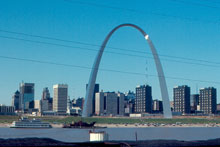 3. St. Louis, Missouri 3. St. Louis, MissouriPopulation: 355,151 Violent Crime Per 1,000: 17.5 2010 Murders: 144 Median Income: $34,801 (30.7% below national average) Unemployment Rate: 9.3% (0.3% above national average) Violent crime in St. Louis fell dramatically between 2009 and 2010, and has decreased since 2007. Despite this, crime rates remain extremely high compared with other cities. In 2010, the city's murder rate and rate of aggravated assault were each the third worst in the country. With regards to both violent and nonviolent crime, St. Louis was rated the most dangerous city based on FBI data released six months ago. As of December 2010, the murder rate in St. Louis was 6.3 times that of the state of Missouri. The city's gunshot murder rate for residents between 10 to 19 years old is also the second highest in the country, behind only New Orleans, according to the U.S. Centers for Disease Control and Prevention. 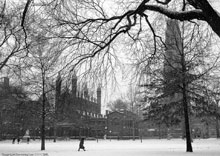 4. New Haven, Connecticut 4. New Haven, ConnecticutPopulation: 124,856 Violent Crime Per 1,000: 15.8 2010 Murders: 22 Median Income: $38,279 (23.8% below national average) Unemployment Rate: 9.6% (0.6% above national average) New Haven has historically had the highest rate of violent crime on the east coast. The impoverished, crime-ridden parts of the city stand in stark contrast to affluent Fairfield county to the West, and elite Yale University, which is located within the city itself. The number of murders in the city doubled last year. New Haven has the eighth highest rate of robbery and the fourth highest rate of assault in the U.S. The New Haven Police Department is considering adding cameras at every intersection in one of the neighborhoods where shootings are the most common. 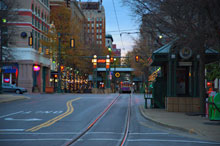 5. Memphis, Tennessee 5. Memphis, TennesseePopulation: 673,650 Violent Crime Per 1,000: 15.4 2010 Murders: 89 Median Income: $34,203 (31.8% below national average) Unemployment Rate: 9.9% (0.9% above national average) Memphis has high rates for all the violent crimes considered for 24/7 Wall St.'s rankings. It has the sixth highest rate in the country. Incidents of violent crime in the city dropped slightly less than 15% between 2009 and 2010 though. Memphis Mayor AC Wharton attributes this decrease to Operation Safe Community, a citywide plan developed in 2005. The plan consists of a number of strategies meant to increase crime prevention, through toughening punishments for criminals, and the effectiveness of the city's legal system, through changes such as expanding court programs so that they operate consistently and at full capacity. 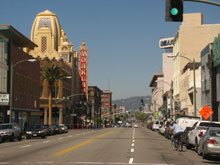 6. Oakland, California 6. Oakland, CaliforniaPopulation: 409,723 Violent Crime Per 1,000: 15.3 2010 Murders: 90 Median Income: $51,473 (2.4% above national average) Unemployment Rate: 11% (2% above national average) Oakland's violent crime dropped about 5.5% between 2009 and 2010, from about 6,800 to 6,260. The city nevertheless has the tenth-highest rate of rape, the ninth-highest murder rate, and the second highest robbery rate in the country. In 2010, there were 7.12 robberies for every 1,000 Oakland residents. According to an article in the San Francisco Chronicle, Mayor Jean Quan has attempted to combat break-ins and theft by creating programs to keep potential wrongdoers off the streets by starting late-night basketball programs. It it unclear if these policies have worked.  7. Little Rock, Arkansas 7. Little Rock, ArkansasPopulation: 192,922 Violent Crime Per 1,000: 15.2 2010 Murders: 25 Median Income: $38,992 (22.3% below national average) Unemployment Rate: 6.8% (2.2% below national average) Little Rock has one of the highest rates of aggravated assault and forcible rape in the country. Since 2009, reported assaults has increased while reported forcible rapes have decreased. According to Lt. Terry Hastings of the Little Rock Police Department, quoted by local station FOX16, Little Rock was "down almost 12 percent across the board on crime" in 2010. This may be accurate for many crimes, and especially nonviolent crimes, however, according to FBI data, violent crime increased from 2009 to 2010.  8. Baltimore, Maryland Population: 639,929 Violent Crime Per 1,000: 14.6 2010 Murders: 223 Median Income: $38,772 (22.7% below national average) Unemployment Rate: 7.4% (1.6% below national average) Baltimore had the eighth-highest rate of violent crime per capita in 2010 among cities with 100,000 or more residents, and the second-highest east of the Mississippi. The number of violent crimes has dropped slightly in the past year -- from 9,600 to 9,300 -- but the Maryland city has some of the worst rates of dangerous offenses in the country. This includes the tenth-worst aggravated assault rate -- and the fourth-worst murder rate in the country.  9. Rockford, Illinois Population: 156,180 Violent Crime Per 1,000: 14.5 2010 Murders: 20 Median Income: $36,990 (26% below national average) Unemployment Rate: 13.3% (4.3% above national average) Rockford has unusually high violent crime rates for a city of its size. Most notably, the city has the fourth highest rate of aggravated assault in the country, with 10.5 cases for every 1,000 citizens in 2010. During the same period, 20 murders occurred, almost double the number in 2000. Quoted by the Rockford Register Star in 2007, Winnebago County Sheriff Dick Meyers said that he believed the city's "location worked against [it,]" as Rockford receives traffic from the drug markets in Madison, Chicago, and Milwaukee, resulting in heightened rates of violence.  10. Stockton, California 10. Stockton, CaliforniaPopulation: 292,047 Violent Crime Per 1,000: 13.8 2010 Murders: 49 Median Income: $45,730 (8.9% below national average) Unemployment Rate: 18.4% (9.4% above national average) With a jobless rate of 18.4%, up from 18.1% a year ago, Stockton, California has one of the worst unemployment problems in the country. The huge percentage of unemployed residents may have contributed to horrible crime rates in the city, which is located 40 miles east of Oakland and San Francisco. Stockton was rated one of the most miserable cities to live in the country by Forbes in March, 2010. Violent crime was one of the chief measurements for its ranking. Of the 267 cities with populations over 100,000, Stockton has the 27th highest number of murders per 1,000 people and the 12th most aggravated assaults per 1,000. Last year, recognizing the crime problems in the city, the state temporarily diverted hundreds of California Highway Patrol officers to aid the city's overwhelmed police department. William H. McDonald Advocates for Change | |
Sunday, September 18, 2011
Friday, September 16, 2011
Thursday, September 15, 2011
Monday, September 12, 2011
Major U.S. Cities Are Emptying of Black Children
Major U.S. Cities Are Emptying of Black Children | |||
Black children leaving large U.S. cities in droves, analysts say for a variety of reasons By DAVID B. CARUSO, Associated Press July 1, 2011 NEW YORK - A catastrophic flood emptied New Orleans of much of its black youth. Powerful social forces may be doing a similar thing to places like Harlem and Chicago's South Side. Over the past decade, the inner-city neighborhoods that have served for generations as citadels of African-American life and culture have been steadily draining of black children.
Last year's census found that the number of black, non-Hispanic children living in New York City had fallen by 22.4 percent in 10 years. In raw numbers, that meant 127,058 fewer black kids living in the city of Jay Z and Spike Lee, even as the number of black adults grew slightly. The same pattern has repeated from coast to coast. Los Angeles saw a 31.8 percent decline in its population of black children, far surpassing the 6.9 percent drop in black adults. The number of black children in Atlanta fell by 27 percent. It was down 31 percent in Chicago and 37.6 percent in Detroit. Oakland, Calif., saw a drop of 42.3 percent, an exodus that fell only 6 percentage points below the decline in flood-ravaged New Orleans. Overall, the census found nearly a half-million fewer black children living in the 25 largest U.S. cities than there were a decade earlier. By comparison, the number of black adults living in big cities has hardly budged.  Demographics experts said a combination of factors appeared to be at work. Americans in general are having fewer children than they once did, due mostly to increased use of birth control. That has been true, too, among black mothers. Teen pregnancy rates among blacks have also plummeted. Demographics experts said a combination of factors appeared to be at work. Americans in general are having fewer children than they once did, due mostly to increased use of birth control. That has been true, too, among black mothers. Teen pregnancy rates among blacks have also plummeted.But the more significant trend, experts said, may be a migration by young black parents to the suburbs. For many, that pull of a place with safer streets, higher-achieving schools and more housing space for the dollar has apparently simply overridden any desire to stay in flawed inner-city neighborhoods, simply because they are black capitals. "I'd been in Harlem for 16 years, and when I first came, I was young, and I was excited and it was a Mecca. But progressively each year, it got rougher and rougher to be here," said Rachel Noerdlinger, a publicist whose clients include the Rev. Al Sharpton. "The violence. The profiling by the cops. I just started to get really, really frustrated." Finally, she decamped across the Hudson River to the suburban quietude of Edgewater, N.J., taking her 14-year-old son with her. "He misses Harlem. He's a teenage boy who, unfortunately, grew up here. Edgewater is quiet and slow. He's constantly complaining," Noerdlinger said. But as for herself, she said: "I'm in heaven. I just love it. ... If I had done this 20 or 16 years ago, I would be a completely different person." In several cities, the change has come just as historically black neighborhoods have been making a steady recovery from decades of horrific decay and neglect. Oakland, a city fraught for years with violence and high poverty rates, has at last been experiencing a renaissance, but the number of white hipsters, Asians and Hispanics moving in has been outpaced by the number of black families that have disappeared. | |||
One In Four Young Black Men in New York Have A Job
With 75% of young Black men in New York City unemployed, some pray that they don't develop a political consciouness -- they would become dangerous!!! Chicago, Philadelphia, Baltimore, Boston, Detroit, Milwaukee are just as bad or worse! Without direct, swift and positive action, in so many words, the U.S. is telling young Black men, "Be poor, uneducated, unemployed, over-incarcerated, non-violent and happy!" How will young Black men respond to this request? | |||
Only One In Four Young Black Men in New York Have A Job: Study
December 14, 2010 A new study paints a bleak portrait of the unemployment landscape faced by young black men in New York City. The headline of the report, filed by the Community Service Society of New York reads, "Only One in Four Young Black Men in New York City Have a Job." The study finds that the unemployment rate for African-American men in New York, between the ages of 16 and 24, was 33.5 percent from January 2009 through June 2010. By comparison, the jobless rate amongst all New Yorkers in that age range was 24.6 percent. But the real startling figure is that employment-population ratio, the percentage of working-age population who have a job, for young black men decreased from 29% in 2006-2007 to 25% in 2009-2010, meaning that one in four black men were employed. For those without a high school diploma, the numbers spiked alarmingly -- this group's unemployment rate was 52%, with 86% percent of these men out of the labor force (essentially that 1 in 10 were employed in 2009-2010). From the New York Times: "The recession has created a landscape of the unemployed and underemployed with particular catastrophic consequences for young African-American men," said David R. Jones, president of the Community Service Society, an advocacy group for New York's low-income residents. "Now young black men between 16 and 24 years have become the banner of hopelessness, particularly here in New York City." The Times also notes that close to 40 percent of black New Yorkers who had held a job previously were unemployed for more than 12 months during the recession and early part of the recovery. That compared with 24 percent for whites, 27 percent for Latinos and 26 percent for Asians. | |||
Sunday, September 11, 2011
Troy will die on September 21
Troy Davis has 10 days to live before he is executed by the State of Georgia. But 7 witnesses say Troy is innocent, and that another man committed the crime for which he will be killed.
With just days left to save Troy’s life, his sister Kim Davis started a petition on Change.org asking the Georgia Parole Board to stop his execution. Please add your name to Kim’s petition now and save her brother’s life.
Evidence presented at Troy’s trial was considered shaky at the time. Since then, seven witnesses have recanted their testimony, many saying they were pressured by police into false testimony.
There’s no physical evidence Troy committed the crime. And, according to Amnesty International, nine people have signed affidavits implicating another man.
Georgia’s Board of Parole and Pardons has said there should be "no doubt" about a person’s guilt before he is executed. You can tell the Board there’s simply too much doubt about Troy’s guilt to kill him next week.
Please click here to add your name to Kim Davis' petition asking the Georgia Parole Board to stop her brother’s execution, then forward this email to everyone you know:
William H. McDonald
ADVOCATES FOR CHANGE
Friday, September 9, 2011
Dads take a child to school 2011 flyer and program
''DAD'S TAKE A CHILD BACK TO SCHOOL''
SEPTEMBER 20, 2011
Men make the difference!!!
We are calling all fathers, stepfathers, foster fathers, grandfathers, godfathers, uncles, brothers, significant male caregivers, next door neighbors, mentors, ministers, pastors, deacons, trustees and other men to: ''Take A Child to School on Tuesday, September 20, 2011''
  
It is said that Men are not involved in their children's education. Last year that myth
was dispelled. On the first day of school in New York City we are asking Men to start the school year off right by participating in this event. On the first day of school let's see a Million Men escorting the children back to school.
This year Community District Education Council 29 will be looking to take this effort to the next level. We will be calling on Men to have a more active role in supporting the education of the children. There are many ways this can be done. It will not take a lot of time, but it will be time well spent. As we all know the most important investment that we will make in our lives, will be the investment that we make in our children. This year we will supply them with the tools that they need to compete in the global economy. This year we will strive for College and Career readiness!!!
Please mark your Calendars,
Let's have a good turnout!!!
Date: September 20, 2011
Place: Your child's school
Address:
Time:
We will be having other events throughout the year, if you or your school/org. would like to participate, send your name, school/ orgs. Name and Contact info. to the email address below.
Thank you for supporting the Children,
William H. McDonald
CDEC 29, MALE INITIATIVE COMMITTEE
Men make the difference!!!
We are calling all fathers, stepfathers, foster fathers, grandfathers, godfathers, uncles, brothers, significant male caregivers, next door neighbors, mentors, ministers, pastors, deacons, trustees and other men to: ''Take A Child to School on Tuesday, September 20, 2011''
  
It is said that Men are not involved in their children's education. Last year that myth
was dispelled. On the first day of school in New York City we are asking Men to start the school year off right by participating in this event. On the first day of school let's see a Million Men escorting the children back to school.
This year Community District Education Council 29 will be looking to take this effort to the next level. We will be calling on Men to have a more active role in supporting the education of the children. There are many ways this can be done. It will not take a lot of time, but it will be time well spent. As we all know the most important investment that we will make in our lives, will be the investment that we make in our children. This year we will supply them with the tools that they need to compete in the global economy. This year we will strive for College and Career readiness!!!
Please mark your Calendars,
Let's have a good turnout!!!
Date: September 20, 2011
Place: Your child's school
Address:
Time:
We will be having other events throughout the year, if you or your school/org. would like to participate, send your name, school/ orgs. Name and Contact info. to the email address below.
Thank you for supporting the Children,
William H. McDonald
CDEC 29, MALE INITIATIVE COMMITTEE
''Dads Take A Child To School''
Program overview & suggestions:
Exp: Dads Brunch, Dads Basketball game, Dads Mentoring young males, Dads night out, Daddy Daughter Dance etc.
Take plenty of pictures!!!
This year the official kick off day for ''Dads Take a Child to School'' in New York City is Tuesday, September 20, 2011. We have the support of the Mayors office, the NYC Dept. of Education and many civic and community organizations.
To register, just reply to this email your school and contact info.
- Dads/Males bring the children to school on the designated day.
- PTA / Parent coordinator / Staff- invites school/local vendors, elected officials, Civics and other community orgs. to welcome Dads and children back to school. Have handouts and other info. Dads will need to assist in their child's education.
- Some schools combine this with a ''Back to School, Stay in School'' program.
- Sign-in sheets provides for outreach to Dads in the future. ( a must have ).
- Dads take a child to school is a step towards getting dads involved. Schools should be arranging events during the year targeting Dads and Male care givers.
Exp: Dads Brunch, Dads Basketball game, Dads Mentoring young males, Dads night out, Daddy Daughter Dance etc.
- Data shows having a strong presence of Dads/Males involved in the education of their children makes a huge difference in closing the achievement gap. Dads take a child to school, founded in Chicago is part of the ''Million Man March''. It is a nationwide effort and the goal is to have over a million men bringing their children to school on the first day and beyond. Remember the key goal is to increase the involvement of Dads/Males in the education of their children.
Take plenty of pictures!!!
This year the official kick off day for ''Dads Take a Child to School'' in New York City is Tuesday, September 20, 2011. We have the support of the Mayors office, the NYC Dept. of Education and many civic and community organizations.
To register, just reply to this email your school and contact info.
Good luck,
William H. McDonald
CDEC-29 Male Initiative Committee
William H. McDonald
CDEC-29 Male Initiative Committee
The United Black Men of Queens County Inc.
Thursday, September 8, 2011
Wednesday, September 7, 2011
Community Education Councils, parents meet at UFT
Community Education Councils, parents meet at UFT
Standing up for kids
PUBLISHED JUNE 23, 2011
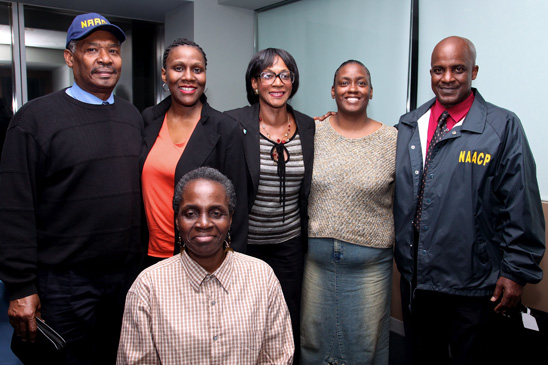 Miller PhotographyAmong those to turn out for the meeting are (from left) George E.M. Gibson, the president of the NAACP - Corona East-Elmhurst; T. Elzora Cleveland, president of the District 2 CEC; Denise Sullivan of the Citywide Education Council on High Schools; Almeta Trammel of CEC District 7; and William McDonald of the NAACP, and (seated) Bronx parent Constance Asiedu.
Miller PhotographyAmong those to turn out for the meeting are (from left) George E.M. Gibson, the president of the NAACP - Corona East-Elmhurst; T. Elzora Cleveland, president of the District 2 CEC; Denise Sullivan of the Citywide Education Council on High Schools; Almeta Trammel of CEC District 7; and William McDonald of the NAACP, and (seated) Bronx parent Constance Asiedu.The mayor’s proposed teacher layoffs and the recent UFT, NAACP and parent lawsuit against the Department of Education for closing schools and inequitable co-locations were among the hot topics discussed by parent leaders at a May 23 meeting at UFT headquarters. Members of the city’s 32 Community Education Councils, the Chancellor’s Parent Advisory Council and the four Citywide Education Councils that advocate on behalf of high schools, English language learners and special education students came to discuss their local issues and citywide policies with each other and union leaders during the meeting.
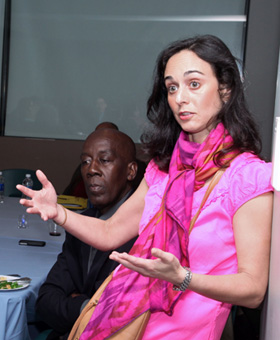 Miller PhotographyJaya Bea Smalley, co-chair of the Citywide Education Council on Special Education, makes a point.
Miller PhotographyJaya Bea Smalley, co-chair of the Citywide Education Council on Special Education, makes a point.UFT Director of Parent and Community Outreach Anthony Harmon welcomed the parent leaders to the meeting and thanked them for their involvement in public education. UFT President Michael Mulgrew provided perspective on the union’s fight against the unnecessary, politically motivated layoffs.
If those layoffs were to happen, parents agreed, it would devastate schools throughout the city, as class sizes are already at the breaking point.
Mulgrew and Harmon said they appreciated the cooperation and collaboration of parent leaders in standing up for what’s right for children in their districts and regions and discussed upcoming opportunities to work together for the good of schoolchildren throughout the five boroughs.
Read more: Around the UFT articles
Sunday, September 4, 2011
Subscribe to:
Comments (Atom)


































